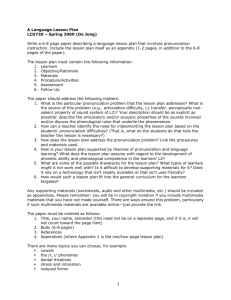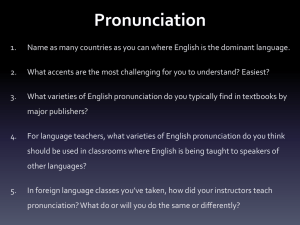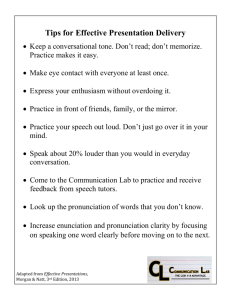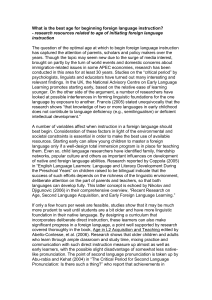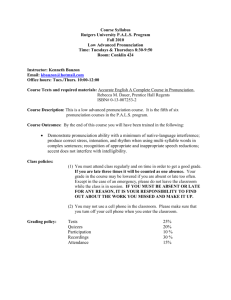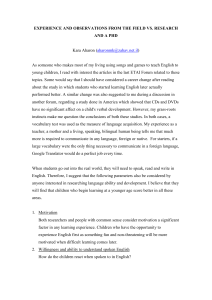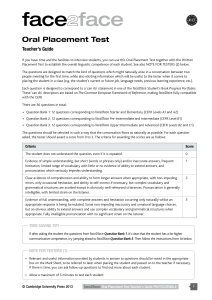Teaching speaking in a second language
advertisement
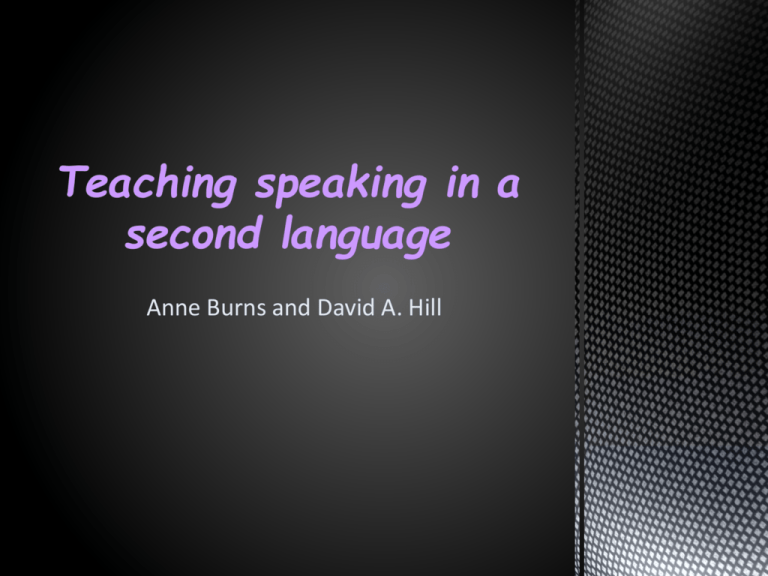
Teaching speaking in a second language Anne Burns and David A. Hill Part one Introduction Recently , teaching speaking has assumed new importance , as educational policymakers internationally have placed greater focus on spoken language skills . Several factors motivate this development . The growth of English as a global language has highlighted of learners emerging from formal learning with the ability to interact effectively with other English users (not native speakers) , or to communicate orally or to international opportunities or cross-curriculum or for employment purposes as a lingua franca which caused teaching speaking effectively . What we know about speaking Quite a lot is now known about the nature of speaking . In broad terms , this knowledge can be described as process-oriented and product oriented . Speaking as process A cognitive process Speaking is a mental process combining various cognitive skills, virtually simultaneously , and drawing on working memory of words and concepts , while self-monitoring . When preparing speaking activities , teachers need to be aware of three important cognitive process . 1- Conceptualization : speakers need the capacity (ability) to select content and ideas for oral production , drawing on sensory imaging and inner speech . In short , learners need sufficient content and background knowledge to be able to say things . 2-Formulation : learners must know lexicogrammatical structure. They must have enough linguistic knowledge to express intended meaning . 3-Articulation : Articulation is a physical process involving appropriate use of mouth , teeth and tongue , its closely linked to memory and to conceptualization and formulation . An affective process Cognitive processing demands can create nervousness or embarrassment for learners . Its important that teachers become aware of the pressures of speaking and develop strategies to minimize anxiety . there are several emotional or psychological factors which may cause learner reluctant to speech including : 1- spontaneous (immediate) speaking involves little time to prepare . 2- Any speaking situation can produce feeling of tension and anxiety . 3- personality traits can affect willingness to speech . Some people are shy or anxious than others. 4- language anxiety can raise from personal or social pressure that comes from fear of mockery or less of face. 5- there maybe gender differences in willingness to speak. According to zhang , male learners can experience greater anxiety when they have to speak English. Speaking as product Pronunciation A foundational aspect of speaking a language is being able to produce the sound patterns instrumental in contributing to meaning and intelligibility .In stress-timed language like English , its important for teachers focus on pronunciation instruction at both segmental(single vowel and consonant sounds or their combinations) and suprasegmental levels , especially for beginners . Suprasegmental elements highlight ‘what knowledge speakers think they share about word , and about each other’s experiences , attitudes and emotions’ 9brazilil et al., 1980,p.15). There is growing evidence that suprasegmental patterns(intonation) are more important in conveying meaning. More recently Jenkins (2000)proposed , controversially , that pronunciation teaching should move away from NS (native speaker) models and focus on more on what non-native speakers(NNS) of English as a lingua franca (EFL) need for comprehensibility . Drawing on analysis of analysis of learner English , she suggests a syllabus based on a ‘pronunciation core’ of sounds problematic for learners .Effective speaking classes should provide activities to help learners work on sound , stress and intonation relate to their needs. Language system Spoken discourse analysis has resulted in substantial insight into the nature of spoken language and its grammatical features. One major insight is that past tendencies to base the teaching of speaking on written language models is no longer productive . Spoken language is highly dynamic , interactive and processed in real time . Written language in contrast , can be planned and redrafted without a physical recipient . Consequently , spoken grammatical features differ notably from written forms. Spoken language 1-Lower number of content words/ higher number of grammatical words. 2-Clauses linked by conjunction(and , but , so) 3_High use of personal pronouns (I , you ,we) 4-Inexplicitreferences into external context(these, it , there) 5-Relationship aspects emphasized (interpersonal foregrounded) 6-Relies more on verbs to carry meaning (verbal process) Written language 1-Higher number of content words/ lower number of grammatical words. 2- Clauses linked by subordination (who , which) 3-Low use of personal pronouns. 4-Explicit references within the context (in the corner , the desk) 5-Content aspects emphasized (information foreground) 6- Relies more on nouns to carry meaning (nominalization) There are some other features which just come in spoken language Adjacency and Ellipsis. Genres of speaking Humans are socially oriented individuals and many daily interactions involve ‘story-telling’ genres to exchange personal experiences feelings and perceptions . Thornbury and Slade identify four major storytelling genres : 1-Narrative (facing/resolving problematic experiences) 2-Anecdote (experiencing remarkable events) 3-Exemplum (highlighting moral points) 4- Experiencing sequences of events) What we think we know about teaching speaking How speaking process ,skills and products can most effectively be transposed into pedagogical practice three major language learning theories can be said to have motivated speaking instruction : 1-Behaviourist 2-cognitivst 3-sociocultural Teaching speaking at this time relied on behaviourist notions of ‘habit formation’_good language ‘habits’ were gained by practicing the same structures repeatedly(drill). An extension of the audiolingual approach which was widely advocated is the PPP sequence. This method is criticized including : Its fixed sequence of learning. Teacher- centredness . Limited focus on communication. Controlled introduction of language structures. -A modal drawing on cognitive theory is Harmer’s Engage ,study, activate. The Engage phase involves arousing learners’ interests , curiosity and emotions towards the topic to attract attention and motivate them. Finally, activate focuses on learners using the language communicatively, drawing on whatever knowledge and skills they have. -Sociocultural learning models embed learning in social and cultural interaction. Socioculturally motivated models include genre , discourse and text-based approaches. currently, these various learning models underpin (support) most teaching approaches . Despite differences in orientation , there seem to be consensus on what key phases constitute effective speaking instruction : -Awareness where learners must come into contact with new knowledge. -Appropriation, where new knowledge becomes incorporated into existing knowledge . -And autonomy where skills become automated and learners move towards greater independence. What we need to find out about teaching speaking Although substantial developments have occurred in our knowledge of where to derive models for speaking and speaking instruction , much remains for further investigation. We highlight two key areas here: Which grammar? Analysis of large corpora of spoken text has contributed extensively to insights into how naturalistic spoken language is realized grammatically. What is very clear is that spoken language is not simply an oral version of written language , even though it is equally clear that they overlap in complex and highly interrelated ways. Since the written grammar use for speaking instruction there is a disservice to continue the learners to language forms that will not advance naturalistic speaking development. McCarthy and Cater note that one difficulty in developing grammars of speaking is determine the core units .Unlike in writing where the sentence is the basic unit , speaking is more problematic , as turns often consists of phrases or incomplete clauses . Given that speaking involves joint interaction deciding on a core unit becomes even more chalenging . Given such challenges , it could be some time before spoken language is codified (arranged principles) for language teaching purposes to anywhere near the same extent as written language. Which speaker norms? The NS as the target is increasingly under criticism, with calls being made for perspectives that recognize global variety and diversity.In relation to NS norms , various questions can be raised . Does NS mean American or British- what about Australian , Canadian or South Africa ? Moreover , for each of these varieties , which NS dialect or pronunciation should be privileged? Are NSs ‘incorrect’ if their phonological, grammatical and lexical variation do not conform to a particular standard? Can competent speakers in non-English-speaking regions be models for speaking instruction? These questions are highly contentious (controversial) and can be researched in relation to teaching speaking. Part two teaching speaking :current textbook practice Introduction In order to examine what is going on in relation to the teaching of speaking in contemporary textbooks , we taking three international coursebooks which span (included) the first decades of the twenty first century : 1- Inside Out ( Macmillian2000) 2- face2face (CUP,2006) 3-Outcomes (Heinle,2010) The main areas of focus are: 1-How far do speaking activities reflect the changing nature of English as a global language and the fact that most interaction in English in the word today are not between NS ? 2- How much concern is shown for the cognitive and affective elements which impinge(have a harmful effect) upon speaking ? How is the learning of pronunciation at segmental and suprasegmental levels catered for How much attention is paid to the true nature of spoken English , as opposed to basing practice on written models ? Does a behaviorist , cognitivist or sociocultural theory of language learning dominate? Brave new words : our theory and methodology Inside out teacher’s book The authors seem to be very aware of the nature of spoken English , starting on the first page that ‘in most situations you move back and forth fairly freely between (speaking and listening). As a result of , students find much of what happens In a nature conversation difficult to deal with’. Later under the heading of Personalized speaking tasks , they say that ‘the main purpose is to develop fluency …. Most of them encourage students to talk about things that matter to them , rather than playing roles or exchanging information. The authors would appear to have understood the nature of natural speech , and to want to offer activities which will help learners to work toward it . There seems to be some attention to the importance of global English , with the varieties of native speaker accents included in the student’s book , and also some NNS ,which is a positive step . There is no meaning of pronunciation in this introduction. face2face teacher’s book In their general overview , the author tell us that ‘there are numerous opportunities for communicative , personalized speaking practice … (with) … lessons in each unit (that) focus on the functional and situational language students need for day-to-day life’ later , under the speaking headline ,there are numerous speaking opportunities. Under the heading of pronunciation, they ensure us that ‘pronunciation is integrated throughout…. with … drills which focus on sentence stress, weak forms, intonation and other phonological features’ As with Inside Out , the authors of face2face seem to favoure the preparation-before-risk taking approach to speaking , which does not match with real world experiences. There seems to be some overt recognition of the importance of pronunciation up front , focusing on a range of important features . Like the Inside Out authors , they also mention the importance of ‘personalization’ in speaking. Outcomes teacher’s book Under a heading called Developing conversation , we are told that ‘the sections teach typical questions, responses and patterns common to conversation. An explanation clarifies the focus while exercises give controlled practice’. This is followed by conversation practice where a task lets students practice social and practical conversations based on their own experience or through role-play’. Under the heading vocabulary the authors say that , ‘vocabulary is carefully chosen to enable students to talk about the topic in the context of English as a lingua franca’. Later they say that, ‘we all know from experience and research that people learn a new language when they are struggling to express something and the ‘correct’ or better word is given . This is also why we have lots of speaking activities . They are not just opportunities for students to practice what they know . they are chances for them to try and say something new , stretch themselves and make mistakes… . What actually goal on in the student’s book? How far do speaking activities reflect the changing nature of English as a global language , and the fact that most interaction in English in the world today are not between two NS Inside out There is a cast of international people to talk about . Some dialogue include different NS of English, and occasionally a NNS. In general it is very wide –British /American . Face2face There seems to be little attempt at any global focus . There are a few nonwhite, non-British /American can type characters , but their impact is minimal and their purpose is not for exploration of communication between different speakers of English . little that happens in the book seems to take place outside Britain and most of the interaction is between white NS. Outcomes There are rather more non-white-British/American characters evident is photos , and situation are set elsewhere to a grater extent in this book. However , conversation do not really reflect any global contexts. How much concern is shown for the cognitive and affective elements which imping(have a harmful effect)upon speaking? Inside out There is one overt mention of how to deal with a topic where negative affective issues might be encountered, e.g. if dating is too sensitive a theme in your student’s culture to allow them to discuss it comfortably. In general, the authors seem to imagine that the progressive build-up to speaking activities will be sufficient to allay any anxiety, nervousness, shyness, etc. there is little opportunity for students to select what they want to say or talk about. Face2face There is nothing overt here to help students, either cognitively or effectively, unless one counts the inexorable (unstopped) build-up of reading, writing, listening and vocabulary exercises through each unit. Outcomes The cognitive side is catering for as far as it is in the other two courses, but there is no real overt help with the affective issues that might affect students. Students are then asked to use certain adjectives encountered in phrase. There are no suggestions in the teacher’s book about helping students to talk about these things. How is the learning of pronunciation at segmental and suprasegmental levels catered for? Inside out There is a little work on individual sounds (e.g. minimal pairs), word stress in sentences, stress timing, short vowel sounds, pure vowel sounds. Some of these exercises involve knowing phonetic symbols. It is all segmental. face2face Topics such as strong and weak forms are deal with from time to time, the difference between British and American accents is also deal with once. Also in many of the dialogue recording scripts in the back of the Student’s book , weak form are written phonetically and interword connectivity is shown. This is a welcome and unusual feature. But does simply drawing learners’ attention to such features actually facilitate acquisition of the features? Outcomes There is regular, if limited, pronunciation work on topics such as: sentence stress and intonation, connected speech, vowel sounds, consonant sounds, question tag, diphthong. The stress and intonation theme shows up several times for different kinds of utterances. It is hardly systematic, though it does have a mixture of segmental and suprasegmental work. How much attention is paid to the true nature of spoken English, as opposed to basing practice on written models? Inside out the modal dialogues still red like written English. There are no overlaps, false starts, repeats, etc., although there is usually a lot of colloquial and informal English and some ellipsis. face2face The modal dialogues are all very similar to those in Inside out-nice and clear, separated speech, some colloquialisms and ellipsis. Outcomes There is a continual insistence on recent colloquial English in this book. The authors go out of their way to introduce it in sections called Native Speak English ( e.g. ‘I’m really into jazz’; ‘How come?’; ‘you don’t want to get ripped off’). Elsewhere, the sequence is similar to Inside Out and face2face, where a series of activities on vocabulary, listening and pronunciation leads into a Developing Conversations section with examples of the comparative, and then a Conversation Practice section to use the language of the earlier parts of the unit. The model dialogues follow the pattern of the other two courses. Does a behaviourist, cognitivist or sociocultural theory of language learning dominate? Inside out The typical process for getting to a speaking activity is: i. Read a text about a topic. ii. Do an activity which examines the language used in the text (reading/written exercise). iii. Talk to your partner about the same topic related to you. There is no specific help for the ‘partner’ how are they supposed to interact? Just be a passive listener? face2face The process for moving to a speaking activity is very similar to that Inside Out. Outcomes Because of the initial speaking activities n many units, this coursebook offers students an opportunity to sink or swim, which is lacking in the behaviorist model-based process of the other two. They end up being less materials- and teacher-led and get an opportunity to stand on their own two feet, being involved in an activity which invites them to use the language resources they have, which is what often happens in real-life interactions. Conclusion What is disappointing is that coursebooks have not really develop very much in the past decades, like these three books which stuck in the behaviorist PPP way of working. There is the scant attention paid to pronunciation in all three books. Another things are lack of support for the ‘partner’ in all of the speaking activities or lack of global approach to the dialogue and interactions. Publishers should present realistic models of interaction and provide activities which help them to cope with real dialogue to use their English, such an approach would require the following sequence of events: •Initially, and at regular intervals throughout the course, in order for students to become familiar with how people construct meaning in dialogues (interruption, pauses, etc.) •The discussion of familiar topics in the mother tongue in groups of three or four •The presentation of short authentic dialogues in the target language. The transcript is then discussed and analysed at a metalinguistic level, and student find out key things to help them speak: its OK to pause, hesitate repeat, etc. •They are then presented with the vocabulary, and structures needed to talk about the same topic as the dialogue they have been analysing. •Finally they are put into pairs or small groups with tasks to carry out using the new language. Their production is recorded for later analysis.
